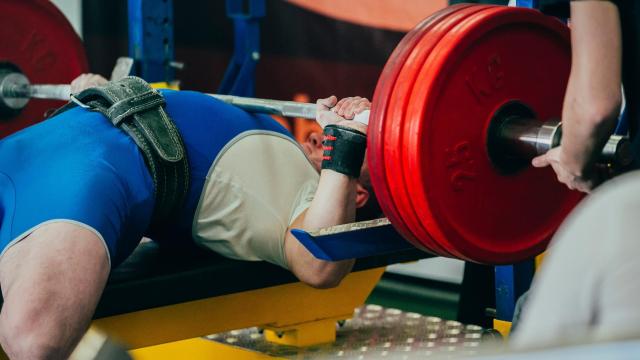Arched bench press is second only to sumo deadlifting in sparking angry online debates about what is the right way to do an exercise. So, just as we did with sumo, we’re going to discuss the pros and cons of the arch, and guide you to a decision about what you should do in the gym, and whether or not it’s worth fighting about on the internet.
What is arching? It’s when a lifter bends their torso in a way that brings their butt and shoulders closer together, belly or chest to the sky. This means that the bar doesn’t have as far to go before it touches your chest. To some, that makes it cheating — but there’s more to the story.
Let’s look up the rules
Cheating means breaking rules, so let’s take a quick look at the rules for bench press in competition. Unsurprisingly, if you’ve ever seen a powerlifting meet, arching is totally legal. Here’s the relevant section from the USAPL rulebook, as one typical example:
The lifter must lie on his [sic] back with head, shoulders and buttocks in contact with the bench surface. The feet must be flat on the floor (as flat as the shape of the shoe will allow).
As long as your head, shoulders, and butt are on the bench, you’re good. You can have your entire back in contact with the bench, or you can arch upward like a rainbow.
As with any controversial technique, there are people arguing that powerlifting should come up with a different set of rules (just as there are arguments that strongman competitions should allow sumo deadlifts or that Olympic weightlifting should allow pressouts) but as it is, arching is fully within the current rules.
Why do people arch?
The only thing detractors tend to notice about the arch is that it reduces the distance the bar has to travel. And it’s true that the few lifters who are able to do an extreme arch only need to move the bar a couple inches.
But there are massive tradeoffs to be made. Just as with sumo deadlifts, if arching were easier and had no downsides, everybody would have an extreme arch. But not everybody has the mobility to make a big arch, and not everybody who can get their body into position is actually strong in that position.
Arching provides stability
The biggest reason for an arch, for many gym-goers, is that it helps to keep your body strong and stable while you’re bench pressing. Even if I’m floor pressing, I try to get a little bitty arch in my back to support and stabilise my body.
An arch also helps with leg drive. When you’re benching powerlifting-style, you want to push your feet into the floor to further stabilise your body and allow all your upper body’s energy to go into pushing the bar upwards. Arching at least a little bit is necessary to get good leg drive.
Arching can help keep your shoulders healthy and comfortable
Many lifters say their shoulders feel better when they use an arch in their bench press. This will vary from person to person, based in part on your body type; for some people, a moderate arch feels good and an extreme one is uncomfortable. For others, the more arch the better.
But isn’t it dangerous?
While a neutral (more or less straight) spine is desirable in many lifts, it’s not important in the bench press. You aren’t asking your back to support weight in the same way you would if you were squatting; your back is just stabilizing while your chest and arms do the work.
Some people are more flexible than others, so there’s a natural reaction when we see somebody doing a thing we can’t to think that if it would hurt us, it must also hurt them. That’s not the case, of course: A gymnast thinks nothing of doing the splits even if I, watching from the couch, can’t imagine anything other than pain from doing the same.
If you want a full anatomical breakdown of what’s happening in a bench arch, sports physiologist Mike Israetel has one here. It’s fine.
All that said, some body types will never fully escape criticism from the armchair coaching crowd. My back isn’t very flexible so my arch isn’t a dramatic one, and even I occasionally get “aren’t you going to break your back” comments if I post a bench video on social media.
Meanwhile, big guys with a big chest or belly have a reduced distance of bar travel just because of the size of their body, and nobody tells them that they’re cheating. And they’re probably arching too, it’s just harder to see that because there isn’t as much daylight under their back as there is on a smaller lifter. They don’t get constant concerns about the supposed health of their spines. In other words, arching is one of those things that women get a lot more criticism for.
So what should you do?
If you’re not competing and just want to get the most out of your bench press, you can arch as much or as little as you like. I don’t compete in powerlifting anymore (I tried it once, it was fun) but I still arch when I bench. It feels good and stable and helps me lift more weight.
If you’ve been benching with a flat back all along, that’s fine. You don’t need to arch. But you may want to give it a try to see if it feels better for you, or lets you lift more weight. This video from Juggernaut gives a bunch of tips on how to use your upper back to properly support a competition-style bench, and it includes tips on setting up for a good arch.

Leave a Reply
You must be logged in to post a comment.